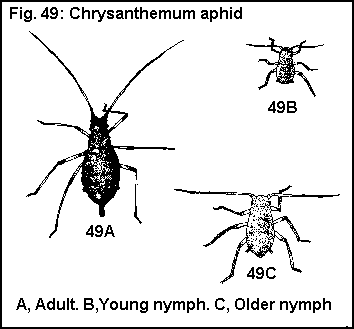DESCRIPTION Adult- This is a small aphid, smaller than most other aphids. The winged adults are about 1.25 mm long, soft bodied, and yellow to dark green with a black head and thorax. The wings are held rooflike over the abdomen at rest. Wingless adults tend to be 1.0 to 1.5 mm long, uniform in color, and yellow to dark green. The antennae and cornicles are shorter than those of winged adults. Cornicles are small, tail-pipe-like structures on the end of the body. Pale individuals tend to be smaller and to have fewer antennal segments than dark individuals. Nymphs- Nymphs resemble adult aphids except for size (about 0.5 to 1.0 mm long). Those destined to be winged adults have wing buds in the later instars.
Fig. 51: Melon or Cotton Aphid, Aphis gossypii Glover, Aphididae, HOMOPTERA A-B, Winged adults.
BIOLOGY Distribution- The melon aphid is apparently distributed throughout the tropic, subtropic, and temperate zones of the world. It is more of a problem in the southern portions of the United States. Host Plants- Melons and other cucurbits, okra, hops, strawberries, beans, spinach, tomatoes, clover, asparagus, citrus, catalpa, violet, hydrangea, begonia, ground ivy, and weeds are some melon aphid hosts. They have been discovered feeding on plants in 25 plant families. The melon aphid is an important pest of cotton and is also called the cotton aphid. Damage- The melon aphid feeds by piercing the plant surface with its threadlike mouthparts to suck out plant juices. This feeding causes distorted growth, decreased yield, reduced quality of yield, and prematurely ripened fruit. The fruit may be covered by the feeding aphids' honeydew and by cast skins. The melon aphid transmits several important plant viruses including cucumber mosaic, onion yellow dwarf, citrus quick decline, lily symptomless diseases, and lily rosette. Life History- The melon aphid is an important pest of both agricultural and ornamental plants. Being practically omnipresent, it feeds upon many host plants. The melon aphid spends the winter on weed hosts and on cold-tolerant plants probably both as nymphs and adult females in the south. During warm periods of winter they start feeding until cold weather inactivates them again. In the spring the adult females move to new hosts and start feeding and rapidly reproducing. In northern climates the aphid overwinters in the egg stage. Indoors and in greenhouses the aphids feed and reproduce throughout the winter. Melon aphids commonly start out on one plant and spread out from that point. On woody ornamentals such as gardenias, feeding is confined to new growth in the spring. For the melon aphid there are two kinds of hosts, primary and secondary. In late fall, aphids feed upon primary plants mate and lay overwintering eggs. Melon aphids feeding on secondary plants always give birth to live young. In spring, 21 winged forms usually infest new plants, both primary and secondary, and the females produce live nymphs. Within about a week the new nymphs mature into wingless females that begin to bear young of their own. As the plant becomes crowded, more and more of the offspring develop into winged females which in turn migrate to other plants to begin new infestations. CONTROL Syrphid fly maggots and ladybird beetles and their larvae feed upon melon aphids. Braconid wasps parasitize the aphids, and ants feed on the honeydew excreted by feeding aphids. Because the winged forms are 2 to 3.7 times more resistant to organophosphate pesticides than are wingless forms, infested plants in the greenhouse should be sprayed thoroughly when aphids are first noticed. Wingless forms usually predominate in low aphid populations. On outdoor ornamentals natural enemies may control minor infestations. For specific chemical controls, see your county Extension agent or consult your state's pest management guide for the control of ornamental plants. |
